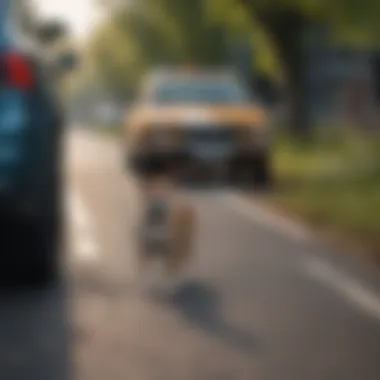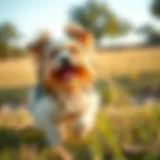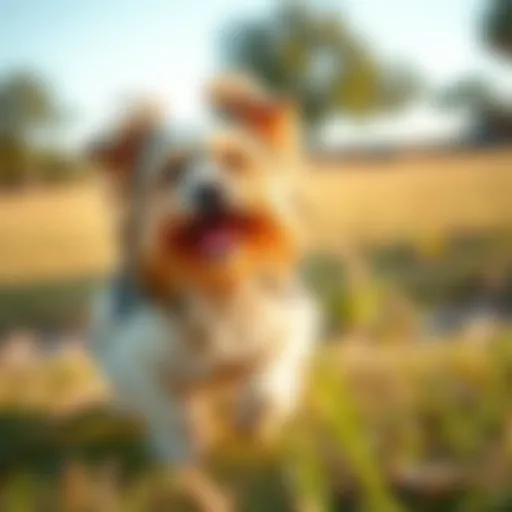Training Your Dog Not to Chase Cars: A Comprehensive Guide


Intro
Training your dog not to chase cars is not just about preventing accidents; it is a significant aspect of responsible pet ownership. Understanding that dogs might have various instincts and reactions to rapid movements helps owners approach this issue thoughtfully. This guide will explore the behaviors behind car chasing, emphasize methods for training, and recommend practical actions to prevent such risks. The insights gleaned can enhance the safety and well-being of your dog, allowing for harmonious interactions within their surroundings.
Animal Species Profile
Intro to the Animal Species
For dog owners, understanding the canines' ancestry provides context to their behaviors. Domestic dogs, Canis lupus familiaris, descend from wolves and share numerous psychological traits. While today's breeds may differ in appearance, retained instincts can manifest as chasing, particularly when stimulated by fast-moving objects like cars.
Physical Characteristics and Appearance
Dogs display a wide variety of physical characteristics. They range in size from small breeds such as Chihuahuas to larger breeds like Great Danes. Factors including fur color, ear shape, and body structure can influence a dog's behavior. These features may contribute to a dog's agility and speed, which play crucial roles in their instincts.
Natural Habitat and Distribution
In the wild, the ancestry of dogs depended on their environments. For domesticated dogs, their habitat has shifted from forests or plains to urbanized areas. Even today, interactions with other species greatly affect their behavior. Urban environments can trigger instinctive reactions, making training crucial for safe outings.
Behavior and Social Interactions
Dogs are social animals by nature. They thrive on interaction, whether with other dogs, humans, or even unexpected stimuli like cars. Their communal behavior can lead to joint chasing interests. It is important to recognize how these social interactions might both strengthen and challenge a dog's ability to learn appropriate responses.
Understanding Why Dogs Chase Cars
Several reasons impact why dogs chase cars. Curiosity, fear, territorial instincts, or sheer excitement can stimulate this action. Understanding the underlying motivation behind a dog’s behavior informs owners on how to tailor their training strategies, ensuring a comprehensive approach to the issue.
Behavioral Modification Techniques
Positive reinforcement is a popular method for modifying dog behavior. This can involve rewarding a dog for ignoring cars or for focused attention on their owner instead. Consistency will ensure the dog learns preferred actions over time. In contrast, punishment is generally not recommended as it might lead to anxiety or distrust.
Implementing practical exercises can further solidify this training. Common techniques involve leash control when approaching roads, engaging distractions, and positive interactions to re-route focus from vehicles.
When to Seek Professional Help
In some cases, a dog’s behavior may be rooted deeply in instincts that require a tailored approach. In such situations, consulting a professional dog trainer or animal behaviorist might be wise. They can provide support and recommend specific corrective methods suitable for your dog’s temperament.
The ultimate goal of training is to foster not only a safe behavior in your dog but also to enhance the relationship between them and their environment.
Ensuring your dog's safety on daily outings involves patience and understanding. Implementing effective training methods will enrich both the dog's life and the experience of pet ownership itself.
Understanding the Behavior
Understanding the behavior of your dog is essential when tackling the issue of car chasing. Dogs have inherently different drives and instincts driven by their evolutionary background. Recognizing these factors helps owners to approach the training process with patience and awareness. By reaching this level of insight, one gains the ability to mitigate risks, apply the right training strategies, and ultimately create a positive environment for both the dog and owner.
The Instinct to Chase
The instinct to chase is rooted in your dog's lineage. Many breeds have been developed specifically for hunting and retrieving, which naturally leads them to fixate on moving objects. When a dog encounters a moving vehicle, their instinctual drive can kick in, often prompting excitement or anxiety. For a dog, a car speeding by can mimic the quick movements of prey. You may notice your dog becomes alert, muscles tense, and ears up when they see a car. Such behavior is completely normal, however, it can pose dangers.
For owners, understanding that the urge is ingrained is essential. Instead of solely reprimanding the behavior, considering it as an inherent part of their nature can foster more effective training. Awareness of this instinct allows for better strategic planning in implementing training routines.
Potential Risks Involved
Chasing cars carries significant risks. First and foremost, it endangers the dog's safety. Collisions with vehicles can lead to serious injuries or even fatalities. The unpredictable nature of traffic means even a well-trained dog can stray into danger when driven by instinct.
Additionally, reckless car chasing behavior can create accidents for driver and passenger safety—both human and animal. If a driver swerves to avoid a dog on the road, it could compromise safety for everyone involved.
Moreover, a dog that habitually chases may also risk developing behavioral issues that extend beyond car chasing. This includes increased anxiety or over-excitement when exposed to stimuli or unfamiliar environments. Recognizing these potential hazards highlights the importance of systematic training techniques, promoting an overall safer environment.
It is crucial for dog owners to acknowledge this instinct and address risks head-on with training and preventative measures to ensure safety.
Assessing Your Dog's Behavior
Assessing your dog's behavior is a critical step in effectively training them not to chase cars. Understanding the factors that contribute to this instinct provides valuable insights for customization of training strategies to suit individual needs. Not all dogs react the same way to vehicles; evaluating their reactions and patterns will help in creating a well-rounded training plan. This closer examination involves identifying specific trigger situations and conducting consistent behavioral observations.


Identifying Triggers
Begin by observing your dog's reactions in various situations. Triggers can vary widely, including loud noises, moving objects, or even the sight of other animals near roadways. When assessing your dog's response, consider the following:
- Environment: Take note of where these reactions happen most often, like in busy urban areas or quiet neighborhoods.
- Frequency: Consider how often your dog chases cars compared to other distractions. Tracking this can reveal the severity of the issue.
- Social Interactions: Watch how other dogs in the vicinity influence your dog's chasing behavior. Interaction with similarly reactive dogs could amplify the behavior.
Identifying triggers allows you to preemptively apply training techniques specific to your dog's needs, thus potentially accelerating their understanding and response.
Behavioral Observations
Observing your dog is an essential part of assessing behavior. Focus not only on moments when your dog is active but also during more relaxed states. Signs to look for include:
- Body language: Is your dog on high alert? Do they have a tense posture or erect ears? Understanding their physical cues can inform the level of concern during potential chasing scenarios.
- Vocalizations: Is there increased barking or whining when a car passes? This can indicate which sounds or movements trigger greater excitement.
- Engagement: Pay attention to how your dog responds to other stimuli, such as pedestrians or cyclists. Comparing these reactions to their behavior when a vehicle approaches can clarify their focus.
Regular observation can highlight patterns. It improves your ability to implement effective strategies, tailoring each approach to specific reactions observed. Consistency in these observations can aid in tracking progress as you train your dog to disregard vehicles.
Understanding the motives behind each chase is critical for effective corrections.
In summary, assessing your dog’s behavior by identifying triggers and conducting detailed behavioral observations lays a solid groundwork. It helps in customizing the necessary techniques to minimize or eliminate dangerous car chasing tendencies.
Preparing for Training
Preparing for training your dog not to chase cars is a crucial step that lays the foundation for effective and sustainable behavior modification. This phase helps owners to create an accommodating environment while strategizing about various methodologies for training. The preparation includes understanding the behavioral patterns of dogs, evaluating the surroundings, and timing appropriate exercises for maximum impact. Without proper preparation, efforts may result in frustration for both the dog and the owner, and training may take longer than necessary, or worse, it may fail altogether.
Creating a Safe Training Environment
Creating a safe training environment is essential for fostering learning without distractions or risks. Dogs respond better in spaces that feel secure and calm. It is advisable to choose a spot away from traffic and other loud noises. This will help keep the dog's focus on the training rather than external excitements. Ensuring physical safety involves using proper leashes and collars that prevent escape or accidental harm to the dog and the owner. Furthermore, consistent surroundings reinforce recognition of commands during training sessions.
- Select a Quiet Area: Choose a less-trafficked area that promotes vigilance.
- Limit Distractions: Reduce or eliminate noise and other factors that could divert attention.
- Use Appropriate Equipment: Ensure the use of safe harnesses and leads that discourage pulling and make control easier.
Overall, the environment must support effective learning without overwhelming the senses of the dog.
Gathering Necessary Tools
Once the training environment is established, the next step involves gathering the necessary tools. This stage includes identifying essential items that will aid training sessions and augment positive reinforcement methods. The right tools can help improve engagement during activities, motivate the dog, and simplify the training process overall. Collecting proper tools beforehand helps make the training sessions more fluid and effective.
Some tools that should be considered are:
- Treats: Healthful and appealing rewards promote success in learning commands.
- Clicker: This is a handy mechanism for providing instant feedback based on the dog's actions.
- Leash: An appropriate length helps maintain control without discomfort for the dog.
- Crates: These offer environments for the dog to safely relax when needed.
- Training Guidebook: A solid resource can sustain long-term results through revised techniques.
Each tool holds significance in enhancing interaction, rewarding efforts, and establishing a framework for clear communication during training. Not using the right tools may not only hinder progress but also lead to the disasters of confusion for the dog.
Effective preparation requires careful consideration of each aspect. Time spent organizing the right setting and tools yields a more rewarding experience for both the dog owner and the beloved pet.
Effective Training Techniques
Effective training techniques are essential for addressing the tendency of dogs to chase cars. This not only ensures their safety but also promotes responsible ownership. Utilizing correct methodologies can shape their behavior, making it manageable, less impulsive, and, ultimately, safer for both the dog and the community. Here are some key aspects.
Positive Reinforcement Methods
Positive reinforcement is a foundational element in modifying dog behavior. This method involves rewarding the dog for desired actions, encouraging them to repeat those actions in the future. Such rewards can be treats, praise, or toys. The key is immediacy; the reinforcement should occur right after the positive behavior. This approach helps the dog to make connections between their actions and the outcomes.
Here are a few benefits of positive reinforcement:
- Greater Retention: Dogs trained with positive reinforcement are more likely to remember commands and behaviors.
- Strengthened Bond: This type of training promotes trust between dog and owner, fostering a better relationship.
- Lower Stress: Positive reinforcement reduces anxiety and fear often associated with punishment-based methods.
Understand that consistency is crucial. Practice commands regularly in safe environments before applying them in complex situations such as those involving cars.
Desensitization Techniques
Desensitization is a gradual process where a dog learns to stay calm and controlled around stimuli that trigger their instinct to chase. This technique involves exposing the dog to the triggering factor (in this case, moving cars) in a controlled manner over time. Start with distant controls where cars are less likely to get the dog's attention. Gradually decrease the distance as the dog adapts without reacting negatively.
The process is generally systematic:
- First exposure should be from a safe distance.
- Observe the dog closely for any signs of stress.
- Interact calmly, using commands learned through positive reinforcement.
- Reward calm behavior to encourage desensitization.


Patience is necessary. Regular sessions help the dog adjust to the presence of cars safely.
Clicker Training Overview
Clicker training is another effective tool for shaping dog behavior. A clicker is a small handheld device that makes a distinctive sound when pressed. This sound acts as a marker for the dog, indicating they have performed a desired action correctly, followed by positive reinforcement shortly thereafter.
The following steps highlight how clicker training can be beneficial:
- Clear Communication: The sound of a clicker provides an immediate signal that the dog did something right.
- Rapid Learning: Many dogs learn faster with this method because of the precise timing of the click.
- Versatility: Clicker training can be applied to numerous behaviors, not just during car chase training.
Using clicker training requires practice:
- Introduce the clicker while associating it with treats.
- Safely apply it when your dog performs a desired action.
- Lessen the treats gradually, rewarding selected moments.
Employing effective training techniques is vital for unhappy problems like car chasing. Doing so ensures better companionship between the dog and its environment,
Culmination
Overall, mastering effective training techniques establishes a pathway for not only managing a dog's unwelcomed chasing behavior but enhancing the overall bond as well.
Steps to Control Car Chasing
Understanding the steps necessary to control your dog’s tendency to chase cars is crucial for several reasons. First, these techniques not only contribute to the safety of your pet but also protect passing motorists. Establishing solid control can minimize the potential dangers associated with this instinctual behavior. Furthermore, following a structured plan can foster trust in the relationship between you and your dog. It transforms what could be a neurotic response into an opportunity for growth that can bolster obedience and responsiveness under any circumstances.
Introducing Basic Commands
The foundation of any effective training regimen lies with the basic commands your dog must learn. Commands like “sit,” “stay,” and “come” should be instinctively understood by your pet. These directives are essential during car-chasing situations. For instance, when your dog begins to dart towards a vehicle, issuing a commanding
Integrating Training into Daily Life
Integrating training into daily life is critical in ensuring that your dog's training doesn’t remain in a controlled environment but extends to every situation they encounter. This iterative process helps form a consistent behavior response, further solidifying the valuable lessons that come with training. It transforms the dog’s perspective, making a stable environment in which they respond well to commands. Engaging your dog in ordinary situations rather than isolates the training can enhance retention and increase bonding between owner and pet.
Having a steady routine that applies training techniques allows both handler and dog to develop confidence. It can clarify the roles in everyday scenarios, and dogs can better comprehend desired behaviors, thus diminishing behaviors like chasing cars. Along with structured routines, incorporating training into daily actions avoids the unpredictability that can complicate behavioral reliance.
Routine Walks
Routine walks are a fundamental part of integrating training into daily life. They serve as everyday exercises that offer both physical activity and behavioral training in real-world contexts. Establishing a consistent schedule reinforces the idea that walks are predictable and safe, thus creating conditions favorable for learning.
During walks, try to make use of certain training commands consistently. For example, employing 'come', 'sit', or 'leave it' commands with ample distractions, like other dogs or cars nearby, is a practical approach to managing instinctual behaviors. Utilising leash control is also essential; limited but firm guidance during these outings ensures safety while also allowing your dog to learn and behave appropriately without constant corrections.
Remember to reward your dog not only for obeying commands but also for walking calmly. Repeat this several times, increasing the distractions gradually. This method allows your dog to associate new experiences with comfort, and bolster their self-control in public spaces.
Redirection Techniques
Redirection techniques are invaluable tools in teaching your dog desired behaviors in everyday scenarios. This technique is beneficial when your dog performs unwanted behaviors, such as barking or a tendency to chase cars. Essentially, it involves guiding their attention from something distracting to a preferable action or command.
For instance, if your dog begins to track a moving vehicle, prompt them immediately with a quick and direct redirect. You may choose to utilize a toy, treat, or engaging command to lure their focus back. The aim is to substitute unwanted behavior with something positive.
Using simple commands like 'look at me' can facilitate a rapid shift in attention. Once your dog gazes back at you calmly, reinforce this behavior with praise or treats. Continuity in application reinforces positive outcomes and builds a sense of security. In this way, the redirection aids in changing the unwanted instinctual behavior gradually into one supported and secure practice.
Incorporating structured walks and redirection techniques into daily life not only alleviates risky behavior but also nurtures a better relationship between dog and owner. This creates mutual respect through understanding and security.
Dealing with Setbacks
Training a dog to stop chasing cars can be a complex task. It's normal for pet owners to face setbacks during this process. Understanding how to handle these setbacks is crucial for the success of your training efforts. This section covers common challenges and how to adjust your approach to overcome them.
Understanding Common Challenges
Setbacks can occur for various reasons. Sometimes dogs regress in their training due to distractions or new experiences. For instance, if a dog sees another animal or a fast-moving object, it might instinctively revert to chasing behavior despite previous training. Factors influencing setbacks include:
- Inconsistent training: When training is not performed regularly, dogs might forget learned behaviors.
- Changing environments: A new park or neighborhood can introduce different stimuli that may overwhelm your dog.
- Lack of motivation: If the dog is not engaged or motivated, progress may stall.
Recognizing these challenges helps in formulating effective solutions, making it essential to remain patient while continuously training.


Adjusting Your Approach
To navigate setbacks, it's important to assess your training plan. Adjustments might be necessary to optimize training outcomes. Here are strategies you can apply:
- Revisit Basics: Going back to basic commands can reinforce learned behaviors. Practice recall and sit commands in low-distraction settings before reintroducing movement.
- Increase Rewards: Incentivize good behavior with higher-value treats or toys. If your dog finds greater pleasure in staying calm, it may not chase distractions as often.
- Limit Exposure: If certain areas trigger chases, avoid these areas until your dog is ready for gradual reintroduction. Understanding when to sidestep is strategically preventive.
When to Seek Professional Help
With training your dog to not chase cars, recognizing when it’s time to get professional assistance is of great significance. Some behavioral issues are hard to tackle alone. Thus, identifying serious problems is crucial. It can prevent dangerous outcomes for your dog and others. This section will demystify when to consult an expert and how to find the right person for the job.
Identifying Serious Issues
Every dog is different. For some, the instinct to chase cars is minor. For others, it can signal deeper behavioral issues. If your dog repeatedly chases cars despite your training efforts, it may be an indication of more serious issues. These can include anxiety, aggression, or other behavioral disorders. Key signs to watch for are:
- Persistent Car Chasing: If your dog ignores commands to stop or repeatedly attempts to chase after cars after training.
- Aggressive Behavior: If your dog displays aggression towards vehicles, people, or other animals when they near a street.
- High Anxiety Levels: If your dog exhibits signs of extreme stress that may lead to unsafe behaviors.
- Previous Traumatic Events: If your dog has experienced a negative event related to cars, like an accident, it might need more focused support.
It's better to seek help early if your dog's behavior persistently raises concerns. Experts have tools and knowledge for managing persistent issues effectively.
Finding a Qualified Trainer
Once you recognize the need for professional help, the next step is to find a qualified trainer. This process requires careful consideration to ensure your dog gets the best support possible. Here are some tips:
- Research Qualifications: Look for trainers certified by reputable organizations, such as the Association of Professional Dog Trainers.
- Read Reviews: Check online reviews or ask other dog owners for recommendations. Platforms like Reddit and Facebook can offer insight on local trainers' reputation.
- Observe Training Style: Ideally, attend a class or watch a session beforehand. Ensure their techniques align with your philosophy on training, particularly regarding positive reinforcement.
- Ask Questions: Discuss your dog's specific issues directly with the trainer. Their responses about their strategy will give you an idea if they understand your situation.
- Trial Sessions: Many trainers offer an initial consultation. Use this to assess compatibility between the trainer and your dog.
Investing time in finding the right trainer pays off in the long run. The cumulative benefits can vastly improve not just your dog’s behavior but also the bond you share.
Consulting a behavioral specialist can provide insights and tailored training plans, particularly for dogs with severe chronic issues.
Maintaining Long-Term Results
Maintaining long-term results is crucial when training your dog to not chase cars. This behavior can have dire consequences, not just for your pet’s safety but also for other pedestrians and drivers. Once you have established effective training methods, the next step is to ensure those changes remain embedded in your dog’s behavior. Consistency and reinforcement play vital roles in fostering an environment where your dog remains well-behaved in the presence of cars.
Considerations of Long-Term Training
Long-term success in training involves continuous engagement and modification. It’s important to remember that behaviors can revert or fade without ongoing practice. For a dog to retain these lessons, you must integrate training into everyday life. This entails not only frequent practice but also tailoring the environment to diminish the likelihood of car chasing incidents occurring in the first place. Also, be aware that every dog is unique in how they respond to training techniques, which makes it essential to stay adaptable during the training process.
Additionally, you should recognize the emotional aspect of training. Reducing anxiety and promoting calmness around automibles often requires a tailored approach that remains aligned with your dog's mental wellbeing. Developing a structured plan can aid in systematically achieving these goals and is worth regular revision as situations evolve.
Consistency in Training
A uniform approach to training significantly contributes to your dog’s understanding and retention of learned behaviors. Daily reinforcement of training tasks should include clear and specific commands, which can drastically lessen confusion. Every training session should mirror the last, maintaining the same tone of voice and body language. Whether working through basic commands or practicing with real-world distractions, uniformity helps solidify these lessons.
Key components for consistent training include:
- Setting a fixed schedule for training sessions
- Using the same commands consistently
- Maintaining predictable environmental factors
This structured method clarifies expectations for your dog and reduces anxiety around unpredictable outcomes. Consistent practice allows your dog to build trust in you as a leader, further enhancing when and how they should respond around vehicles.
Reinforcing Positive Behavior
Positive reinforcement builds an atmosphere of encouragement. Recognizing and rewarding good behavior reinforces the desire to act appropriately. Tools commonly used for reinforcement include treats, favorable attention, or playtime. This not only motivates your dog but also lays the groundwork for a trusting relationship.
Strategies for effective positive reinforcement include:
- Timing is crucial; reward your dog immediately after they exhibit desired behavior.
- Gradually phase in varied rewards to sustain your dog's interest.
- Highlight moments of calmness or successful recall when cars are present.
Positive reinforcement can transform a dog's response to a challenging situation, turning inherent instincts towards safer behaviors over time.
This practice helps to mold behavior and keeps the effort fresh and enjoyable. However, it’s equally important to ensure that the reinforcement does not become an expected enticement; otherwise, the behavior might rely heavily on treats or rewards rather than internalizing the training.
Ending
Training your dog not to chase cars is a critical aspect of pet ownership that requires dedication and understanding. This article has outlined essential strategies and techniques to modify this behavior, ensuring both your dog's safety and the safety of others.
Recap of Key Points
It is necessary to revisit the core concepts discussed throughout the guide.
- Understanding canine instincts: Recognizing that dogs have a natural tendency to chase is an essential first step in addressing the behavior.
- Assessing triggers: Identifying specific elements that cause the reaction is crucial for developing a tailored training approach.
- Training methods: Utilizing positive reinforcement and desensitization techniques leads to effective, long-lasting results.
- Professional assistance: Recognizing when to consult a trainer can significantly enhance the training experience for both the dog and the owner.
- Maintaining consistency: Long-term results depend on continuous training and reinforcement of positive behaviors.
Encouragement for Responsible Ownership
As a dog owner, you play a pivotal role in ensuring your pet's safety and sociability. Training may seem arduous at times, but the benefits outweigh the challenges. A well-trained dog not only feels more secure, but also fosters safer environments. A focus on responsible ownership ensures dogs remain part of harmonized communities. Enrich their life through daily engagement and consistent training. Promoting positive behaviors leads to fulfilling experiences and lowers risks in various situations, including those involving cars. Through commitment and active participation in your dog's training, a mutually respectful bond will flourish.







